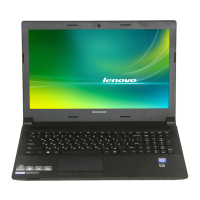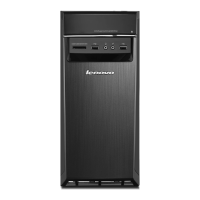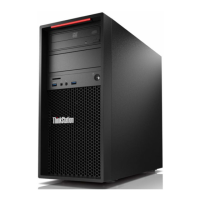Do you have a question about the Lenovo 300 and is the answer not in the manual?
Crucial safety warnings and precautions to be read before servicing.
Guidelines for ensuring overall safety during maintenance procedures.
Precautions regarding electrical hazards and safe handling of components.
A checklist to identify potential hazards before servicing the computer.
Procedures to protect sensitive electronic components from ESD damage.
Essential information on proper grounding for operator safety and system function.
Specific warnings and cautions provided in English for safety awareness.
Details the physical and environmental specifications of the computer.
Instructions on how to access and launch the BIOS Setup Utility.
Guidance on navigating and modifying system configuration options.
Information on setting and managing BIOS passwords for system security.
Details on setting, changing, or deleting the administrator password.
Instructions for setting, changing, or deleting the power-on password.
How to enable or disable various device options within the BIOS settings.
Procedures for changing the boot order or selecting a temporary startup device.
Troubleshooting steps for issues related to hard disk drive boot failures.
Procedures for diagnosing and resolving power supply related issues.
Explanation of Power-On Self-Test (POST) error messages and their meanings.
Troubleshooting steps for issues that cannot be diagnosed through specific errors.
Illustration showing the location of controls and components on the front of the computer.
Diagrams detailing connectors and components on the sides of the computer.
Illustration indicating the location of connectors and ports on the rear of the computer.
An exploded view showing the various internal hardware components of the computer.
Detailed identification of connectors and components on the computer's motherboard.
Essential steps to take before beginning any hardware disassembly.
Step-by-step guide for replacing the keyboard and mouse components.
Instructions for safely removing and installing the external power adapter.
Procedure for detaching the computer's stand base.
Steps to remove the protective foot cover from the computer.
Detailed instructions for replacing the computer's hard disk drive.
Guide on how to remove and install the optical drive.
Steps for detaching the stand holder assembly from the computer.
Procedure for removing the rear external cover of the computer.
Instructions for removing the Electromagnetic Interference (EMI) cover.
Guide for safely replacing the power switch board.
Steps to replace the internal converter board.
Procedure for installing or replacing memory modules (RAM).
Instructions for removing and installing the computer's system cooling fan.
Guide on how to replace the heat-sink assembly for thermal management.
Steps for removing and installing the computer's internal speaker system.
Procedure for replacing the wireless network interface card.
Detailed instructions for removing and installing the main system board.
Guide for replacing the integrated computer camera module.
Instructions for replacing the LCD screen assembly.
Procedure for replacing the non-touch LCD panel module.
Provides supplementary information relevant to service representatives.
Explains how power management reduces energy consumption in computer components.
Details features allowing the computer to turn on automatically at scheduled times or events.
Crucial safety warnings and precautions to be read before servicing.
Guidelines for ensuring overall safety during maintenance procedures.
Precautions regarding electrical hazards and safe handling of components.
A checklist to identify potential hazards before servicing the computer.
Procedures to protect sensitive electronic components from ESD damage.
Essential information on proper grounding for operator safety and system function.
Specific warnings and cautions provided in English for safety awareness.
Details the physical and environmental specifications of the computer.
Instructions on how to access and launch the BIOS Setup Utility.
Guidance on navigating and modifying system configuration options.
Information on setting and managing BIOS passwords for system security.
Details on setting, changing, or deleting the administrator password.
Instructions for setting, changing, or deleting the power-on password.
How to enable or disable various device options within the BIOS settings.
Procedures for changing the boot order or selecting a temporary startup device.
Troubleshooting steps for issues related to hard disk drive boot failures.
Procedures for diagnosing and resolving power supply related issues.
Explanation of Power-On Self-Test (POST) error messages and their meanings.
Troubleshooting steps for issues that cannot be diagnosed through specific errors.
Illustration showing the location of controls and components on the front of the computer.
Diagrams detailing connectors and components on the sides of the computer.
Illustration indicating the location of connectors and ports on the rear of the computer.
An exploded view showing the various internal hardware components of the computer.
Detailed identification of connectors and components on the computer's motherboard.
Essential steps to take before beginning any hardware disassembly.
Step-by-step guide for replacing the keyboard and mouse components.
Instructions for safely removing and installing the external power adapter.
Procedure for detaching the computer's stand base.
Steps to remove the protective foot cover from the computer.
Detailed instructions for replacing the computer's hard disk drive.
Guide on how to remove and install the optical drive.
Steps for detaching the stand holder assembly from the computer.
Procedure for removing the rear external cover of the computer.
Instructions for removing the Electromagnetic Interference (EMI) cover.
Guide for safely replacing the power switch board.
Steps to replace the internal converter board.
Procedure for installing or replacing memory modules (RAM).
Instructions for removing and installing the computer's system cooling fan.
Guide on how to replace the heat-sink assembly for thermal management.
Steps for removing and installing the computer's internal speaker system.
Procedure for replacing the wireless network interface card.
Detailed instructions for removing and installing the main system board.
Guide for replacing the integrated computer camera module.
Instructions for replacing the LCD screen assembly.
Procedure for replacing the non-touch LCD panel module.
Provides supplementary information relevant to service representatives.
Explains how power management reduces energy consumption in computer components.
Details features allowing the computer to turn on automatically at scheduled times or events.
| Operating System | Windows 10 Home |
|---|---|
| Form Factor | Tower |
| Graphics | Integrated Intel HD Graphics |
| Connectivity | WiFi 802.11 a/c, Bluetooth |
| Ports | USB 3.0, USB 2.0, HDMI, VGA, Ethernet |
| Optical Drive | Optional DVD-RW |
| Dimensions | 360 mm x 160 mm x 278.5 mm (14.17" x 6.30" x 10.96") |






![Preview: Lenovo F0B2 [C20-30]](https://data.easymanua.ls/products/594284/200x200/lenovo-f0b2-c20-30.webp)




